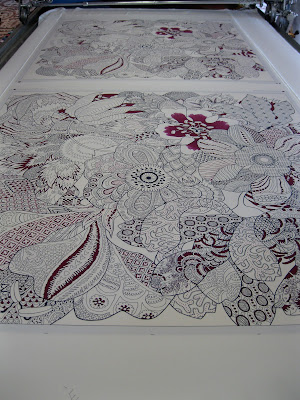Two years of craftsmanship into a one hour presentation is extraordinary for anything, but in terms of something as beautiful as a Hermès silk scarf, it is absolutely extraordinary. The screen printing of the iconic scarves is a process that is as complicated as it is beautiful. Pure white silk in one meter by one meter squares are taped down to a long table (normally 52 meters long in the factory, but only 2 meters long in the exhibit) and screen printed with magnificent designs. The specific scarf that was being printed only had 10 colors (some have had as many as 50), are all painted on the silk, one at a time, via a large screen with mesh.
The blue screen, with each design that is the same color etched into it, is laid on top of the silk and positioned in the exact middle of the 1 meter by 1 meter piece of silk.
The first color printed on the silk is always the darkest, being the black outline of design. So the first print shows the entire design, but without any color, like an unused coloring book. The black paint is dribbled across the top of the screen and is ready to be brushed over the screen.
The painter uses a squeegee-like brush to spread the paint around the screen, so the paint can penetrate the mesh, thus being applied to the silk.
The screen is rolled away, revealing the intricate design of the scarf. This scarf is called Fluers Indiennes (Indian Flowers), and is a montage of classic Indian flowers. The name and the artist will be painted into the design later in the process.
Intricate detail
To ensure absolutely security, the copyright logo and the artist's name is painted separately from everything else on the silk.
Copyrighted Hermès logo
The following colors are applied the same way as the black outline. The next color in this specific scarf is gorgeous aubergine color that gives the scarf an exotic quality.
Intricate detail and color
Hermès uses over 2,000 colors for their scarves. They are all mixed in the factory and cannot be recreated elsewhere. The scarf in the demonstration only has 10 colors, to make the presentation simple. But some scarves can have upwards on 30 different colors.
More color
The name of the print is always displayed within in the design of each scarf. The design is actually bought from different artists that are not associated with Hermès.
More color
Additional color
A border is added to every scarf. This scarf uses a Navy border, which dictates the color of the thread used in the stitching around the perimeter, which takes roughly 45 minutes per scarf.
A timeline of one of the most iconic scarves displays the different stages of painting. The scarf making process is long and tedious, and can be extremely temperamental. One twitch of the screen layer's hand can off set the entire pattern on the last color, making the scarf be destroyed and unusable in Hermès' eyes. After the scarves are painted, they are set to dry, then treated for water resistance. Seeing what goes into a relatively small piece of silk is truly eye-opening and will make anyone appreciate the craftsmanship behind Hermès.
Photos by Tim Schroeder for Standard Luxe






















